Displaying items by tag: ISORA
#isora – Preparing for the offshore racing season and especially the Dun Laoghaire to Dingle race and Fastnet Race is the subject of Wednesday's pre-season ISORA talk at the National Yacht Club on Wednesday at 7pm. 'Prof' O'Connell of North Sails Ireland will talk about "Offshore Trim and Speed" and Mick Liddy will talk about "Offshore Tactics and Navigation".
There will be a wine reception afterwards.
Repaired Raging Bull Aims to Reclaim 2013 ISORA Lynx MetmAsts Championship
#isora – The 2010 and 2011 ISORA champion Matt Davis has vowed to return to the circuit and regain ISORA's famous Wolf's Head trophy in 2013. Davis's chances were scuppered in 2012 when his championship winning yacht Raging Bull broke her moorings and came ashore in gales off Skerries in North Dublin at the start of the season.
The return of the Sigma 400 marks the start of a tough battle for Irish Sea honours next year against the dominant force of the 2012 champion Sgrech, a J109 from North Wales skippered by Stephen Tudor.
The announcement that Lynx metmAsts will sponsor the ISORA Offshore Series for 2013 is a further boost for the growing offshore scene that follows a successful agm where an Irish Sea offhore cohort are expecting to boost numbers on both sides of the Irish sea next season with a number of new initiatives.
Volvo Dun Laoghaire Regatta from July 11 will for the first time feature a coastal series next July for those boats that prefer longer races. It will be a series with four races similar to ISORA's normal day races and ISORA commodore Peter Ryan is strongly encouraging all ISORA boats to compete in this event.
The ICRA Nationals, (June 14-15) hosted by Fenit are also proposing a Costal Series as part of their event.
This series occurs directly after the NYC's Dingle Skellig Hotel Dun Laoghaire to Dingle Race on June 8.
The 2013 race schedule for 2013 will involve 11 races and include the Isle of Man as a new venue. The details of the 2013 races can be downloaded here.
ISORA Salutes its Offshore Winners from 2012
#isora – ISORA saluted its annual prizewinners at a black tie dinner at the National Yacht Club in Dun Laoghaire on Saturday night. The full prizewinners list is available to download as an excel file below. Scroll down for more photos. The ISORA agm agreed the 2013 race programme that will be sponsored by Lynx Metmasts.
Saturday's agm was followed by the annual Prize Giving where some of the most elegant sailing trophies including the overall Wolf's Head Trophy were presented. Having being runner up for the past two seasons the 2012 ISORA Championship Sgrech (Stephen Tudor) was saluted. His hardened offshore racing team from Pwlhelli in North Wales have many years experience of Irish offshore campaigns.
ISORA agm to Agree 2013 Offshore Race Programme for the Irish Sea
#isora – ISORA has issued its 2012 AGM Agenda plus its 2013 draft Race Schedule for the Irish Sea next year. Both are available for download below as pdf documents.
The race programme will be approved on November 17th at the National Yacht Club. Unfortunately the date clashes with the one day Irish Cruiser Racer Conference (ICRA) in Kilkenny where offshore supremo Damian Foxall will give a presentation.
The ISORA agm is followed by the Annual ISORA Prize Giving Dinner at the NYC where some of the most elegant sailing trophies including the Wolf's Head Trophy will be presented.
Tudor's ISORA Win Completes 2012 Offshore Season
#isora – Having being runner up for the past two seasons the weekend winner of the 2012 ISORA Championship Sgrech is no stranger to the Irish Sea, her skipper Stephen Tudor and crew are a hardened offshore racing team from Pwlhelli in North Wales who have many years experience of Irish offshore campaigns for over 40 years.
Sgrech is a 2003 version J109. She was purchased in November 2010 by Hugh Williams, Philip Yapp and Tudor and replaced the team's J92 in which they achieved a very wet second overall in the 2010 ISORA series.
The team also achieved a second overall in Sgrech in 2011 again being beaten by Skerries Raging Bull.
Skipper Stephen Tudor has not yet been successful in persuading his brother, Richard, to join the crew. Richard skippered two circumnavigations in the Chay Blyth's Global Challenges and has provided considerable assistance in particular with Sgrech's preparation.
The 2012 Sgrech crew this year included the three co-owners and Stephen's son Thomas, one of many third generation ISORA competitors.
ISORA Chairman Peter Ryan who was on board Sgrech for the RORC Lyver Trophy race win in 2011 from Holyhead to Howth has also been on board this year to campaign for the ISORA series and June's Round Ireland Race.
Other crew members include RNLI member and veteran Round Ireland sailor Arfon Jones, Australian Andrew Rosewarne and Sarah Pemberton who sailed extensively with Andrew Hall.
The Tudor association with ISORA goes back to the 1970's when we raced with their father (Huw Tudor) on a Golden Shamrock, Gwobr Aur, at a time before DECCA or other navigation aids.
At that time there were regular ISORA fleets of about 40 which I think peaked at about 70. Stephen's first race was to Dun Laoghaire in 1976 (aged 16).
The Tudor's then campaigned a Contention 33, Panache and after that Greased Lightning. Richard and Huw went on to sail Corwynt Cymru III (Winner Class1 Cork Week 1992).
Corwynt Cymru was later renamed and is now known as Raging Bull, the 2011 champion that was wrecked in gales last May.
Welsh Entry 'Sgrech' Wins 2012 ISORA Championship
#isora – A bad weather forecast that prevented Dun Laoghaire boats making the start line meant overall leader "Sgrech" had the championship won before the start of the last race from Pwlhelli to Dun Laoghaire on Saturday writes ISORA Commodore Peter Ryan.
In particular second overall John Maybury's Joker 2 from the Royal Irish YC could not travel. From the list of 22 entries only 12 starters came to the North Wales line at 08.00.
Despite the bad weather on Thursday night and Friday, the weather forecast for Saturday was for light fickle winds, westerly going south westerly but increasing slightly on Saturday evening.
With this forecast in mind the Racing Committee set the course directly to the finish in Dun Laoghaire with Bardsey not being a mark on the course.
Expecting a "mill pond" on the start line boats left the marina to be greeted by 8-10 knots south westerly. The first leg to Tudwal's Island was a beat with "Sgrech" leading the charge. From Tudwal's to Bardsey, the winds veered westerly giving another beat. With the tidal gate closing at mid-day most of the fleet led by "Sgrech" got through with only three boats remaining when the gate closed. However, there was sufficient wind for them to eventually battle through.
The fleet that made the gate were well bunched as they headed towards Dun Laoghaire on a white sail reach in winds of up to 22 knots. The three J boats, "Sgrech", "Jedi" and "Jetstream" led the bunch. For most of this leg no places changed until the winds became fickle again approaching the Irish coast. Spinnakers appeared with 10 miles to go until Dublin Bay threw in its usual "wobbler" with the winds verring westerly. "Jedi" just inched past "Sgrech" during this stage of the race. The last five miles of the race to the harbour mouth was a beat.
The finish provided by Peter Rowley of the NYC was suitably exciting with "Sgrech" on the transom of "Jedi" as she crossed the line. They were soon followed by "Midnight Mojito" and "Jetstream". "Jedi" won the race overall and Class 1 while the new ISORA Champion "Sgrech" took 2nd place overall and 2nd in Class 1. "Yahtzee", a long ISORA campaigner, had it best race result by taking 3rd Overall, winning Class 2 and also Silver Class.
At the end of what was a very successful and enjoyable season the ISORA Offshore Champion for 2012 is Stephen Tudor and "Sgrech". Peter Hall's " Adelie" managed to hold off the two handed, Liam Coyne and Brian Flahive's "Lula Belle" to take Class 2. Neil Eathough's "Lancastrian" did not need to start in this race to win the Silver Class overall. Richard Mossop's "Yahtzee" won Silver Class 2.
All prizes and trophies will be presented at the ISORA Dinner in the NYC on the 17th November. We are honoured that Derek Mathews, Commodore of the Royal Dee Yacht Club will be there to present their "Wolf's Head" trophy to the new ISORA Champion, Stephen Tudor and "Sgrech".
The ISORA AGM will be held at 15.00 on the 17th November in the NYC – the day of the ISORA dinner.
'Tsunami' Pips 'Lively Lady' in ISORA M2 Buoy Race
#isora – There was a great turn out for Saturday's ISORA's day race to the M2 buoy run in conjunction with the Royal Alfred Yacht Club writes ISORA Commodore Peter Ryan.
18 boats came to the start line where RAYC Commodore, Barry McNeaney, sent the fleet off towards the M2 Buoy.
The forecast for the day was south westerlies, 15-20 knots. With the forecast the course direct to M2 and back would ideal giving a dead run out and a beat back. However, the wind backed more southerly turning the run to
a tight reach and the beat into a long leg short leg affair. The tides were also ideal with north going tide at the start for three hours helping progress toward the M2.
After the start the fleet split with half gybing north and the others gybing east. When the fleet converged at the M2 the northern approach appeared to have the advantage with "Lively Lady" rounding first followed by "Tsunami". Immediately behind them were "African Challenge", "Jedi", "Loose Change" and "English Mick"
The wind for the leg back to the finish was very shifty, constantly back and veering between the W, SW and S. The wind strength varied all the time from 8 knots to 22 knots and back!!!! "Lively Lady" held the front position to the finish. The beat across Dublin Bay was tricky as the winds got flukier and lighter.
"Lively Lady" held their position to cross the line first at 17.41 after nearly eight hours racing. However, not far enough ahead to prevent "Tsunami" from taking 1st Overall and 1st in Class 1. "Tsunami" managed to keep far enough ahead of "Jedi" who took 2nd Overall and 2nd in Class 1.
"Lively Lady" took 3rd Overall and 3rd in Class 1. "Lula Belle" took 1st place in Class 2 ahead on "First of September" and "Guillemot".
In the Silver Fleet "Lancastrian" continued its winning run with "Yahtzee" taking 2nd and "African Challenge" taking 3rd.
The next race is the Pwllheli Day Race next Saturday, starting and finishing in Pwllheli. The following Saturday is the last of the 2012 Series, The James Eadie Trophy race from Pwllheli to Dun Laoghaire and will determine the 2012 ISORA Offshore Champion. Can "Sgrech" hold their lead or can "Joker 2" overtake them in the final strait? This race has always been very popular and a large number of starters producing high points for the race could have a significant effect on the results of the Series. A good night is planned in Pwllheli on the Friday before the last race and, weather permitting, an "End of Series" soirée is planned in the NYC after the race.
There is a requirement for crew on some boats for the last race. Anyone interested in crewing should contact me. If there is sufficient demand, the usual "Crew Bus" will be organised for that race to bring crew travelling on the HSS from Holyhead to Pwllheli on the Friday afternoon.
Welsh Yacht Moves into Commanding Lead for ISORA's Overall Trophy
#isora – After the weekend's cross channel offshore race to Pwllheli, the North Wales J109 yacht Sgrech is in a commanding position for ISORA's Wolf's Head Trophy overall but Dublin Bay's Joker 2 (John Maybury) can still steal the silver by good results in the remaining races that are usually well supported writes ISORA's Peter Ryan. RESULTS AVAILABLE FOR DOWNLOAD BELOW AS EXCEL FILE.
The light weather forced the retiral of four boats from the fleet of 12 starters. Some boats retired within sight of the finish line.
The weather forecast for the race was deadly accurate with south westerly 8-10 knots at the start rising to southerly 16-19 knots and falling again in the evening to south easterly 4- 6 knots.
The upwind start crowded many of the boats at the Committee boat end of the line where NYC Vice Commodore, Larry Power, sent the fleet of 12 boats off toward the Muglins. The course for the race was: Start – Muglins (S) – Moulditch Buoy (P) – Finish in Pwllheli. The course allowed boats to pass either side of Bardsey Island and St Tudwal's Island on route to Pwllheli.
Lula Belle got the best clear start from the pin end and raced towards the Muglins while most of the fleet at the other end of the line shadowed each other from the little wind that was there. Lula Belle's early lead soon disappeared as the fleet left Dublin Bay and sailed into a hole in Killiney Bay.
This was not the last hole to be found by the fleet. Killiney Bay caused problems for most of the boats who got trapped with no wind and a strong foul tide. Again, Lula Belle, made a spectacular break from Killiney Bay by sailing deeper into the hole and coming out the other side with a stronger different wind than the remainder of the fleet. Only four boats managed to get away early from Killiney Bay while the rest of the fleet were stranded.
The four boats proceeded towards Moulditch – Lula Belle followed by Sgrech, Joker 2 and Adelie. After Moulditch the leg to Pwllheli was a tight white sail reach. No distance was gained or lost between the four boats as they crossed the Irish Sea. Lula Belle held it lead until the wind dropped as they approach St. Tudwals. Sgrech overtook Lula Belle for the lead heading into Abersoch Bay.
The last section of race to the finish was a light air run. Sgrech managed to pull away from both Lula Belle and Joker 2 to take 1st place Overall and Class 1. Lula Bell held off Joker 2 to take 2nd Overall and 1st in Class 2.
Lancastrian took 1st place in the Silver Fleet to extend his overall lead in this division. For full results see the attached links. The finish in Pwllheli was provided by Gerry Williams, past Commodore of Pwllheli Sailing Club.
The present results puts Sgrech in a commanding position for the Wolf's Trophy overall championship. However, Joker 2 can still steal the silver by good results in the remaining races that are usually well supported.
The next race is the M2 Day Race on the 1st September with a 10.00 start.
The course will be set to ensure that all boats are back in Dun Laoghaire at 19.00 latest.
#isora – With overall ISORA series points very close, Saturday's race from Dun Laoghaire to Pwllheli will be a critical one, being the penultimate cross channel race of the ISORA season. Scroll down to download the overall points file.
Consistent performer Welsh yacht Sgrech skippered by Stephen Tudor continues to lead Dublin bay's Joker 2 (John Maybury). These two J109 designs are followed by “Adelie”.
The actual course for Saturday's cross chanel race will be decided on Friday evening at the National Yacht Club with blustery conditions forecast. Scroll down to download the entry list for Saturday's race.
Meanwhile 21 boats crossed the start line for ISORA's sixth race last Friday for the sleigh ride down to North India buoy off Wicklow with wind and tide behind the fleet.
The 15-20 knot west / north west wind provided a spinnaker start at the Pier mark where Commodore of the Royal Alfred Yacht Club, Barry McNeaney sent the
21 boats off racing toward the Muglins.
On route to North India, the wind veered left to right and from 10 knots to 20 knots. At the North India there was a strong south going tide that swept the fleet past the mark when rounding.
The following two eastward reaching legs around South Codling and East Codling were a practice for the beat to the Muglins and the finish, mostly against the tide.
The clear sky conditions for the race provided a spectacular display of stars and planets to keep crew occupied for the final leg.
The finisher, Peter Rowley was waiting to receive the finishing boats as they crossed the finish line between the Dun Laoghaire harbour lights. “Lively Lady” took line honours. Despite this, the J109’s took the wining and second places with “Joker 2” taking First overall and first in Class 1. “Jedi” took 2nd Overall and Class 1 while “Tsunami” took 3rd Overall and
Class 1.
“Legally Blonde” won Class 2 while “Adelie” took 2nd place and “First of September” took 3rd place.
Joker II Plays the Right Cards to Win Overnight ISORA Race
#ISORA – J 109s continue to fight it out at the top of the ISORA fleet with John Maybury's J109 Joker II taking first place in the 40 mile East coast fixture. 21 boats crossing the start line off Dun Laoghaire on Friday evening for a night time sleigh ride down to North India buoy with wind and tide behind them.
The 15-20 knot west / north west wind provided a spinnaker start at the Pier mark where Commodore of the Royal Alfred Yacht Club, Barry McNeaney sent the 21 boats off racing toward the Muglins.
On route to North India, the wind veered left to right and from 10 knots to 20 knots. At the North India there was a strong south going tide that swept the fleet past the mark when rounding.
The following two eastward reaching legs around South Codling and East Codling were a practice for the beat to the Muglins and the finish, mostly against the tide.
The clear sky conditions for the race provided a spectacular display of stars and planets to keep crew occupied for the final leg.
The finisher, Peter Rowley was waiting to receive the finishing boats as they crossed the finish line between the Dun Laoghaire harbour lights.
"Lively Lady" took line honours. Despite this, the J109's took the wining and second places with "Joker 2" taking First overall and first in Class 1.
"Jedi" took 2nd Overall and Class 1 while "Tsunami" took 3rd Overall and Class 1.
"Legally Blonde" won Class 2 while "Adelie" took 2nd place and "First of September" took 3rd place.
In the ISORA series "Sgrech" continues to lead with "Joker 2" snapping at their heels. "Adelie" is right behind "Joker 2". There is all to play for with two main cross channel races still to take place.
The next race is the race from Dun Laoghaire to Pwllheli on the 18th August.


























